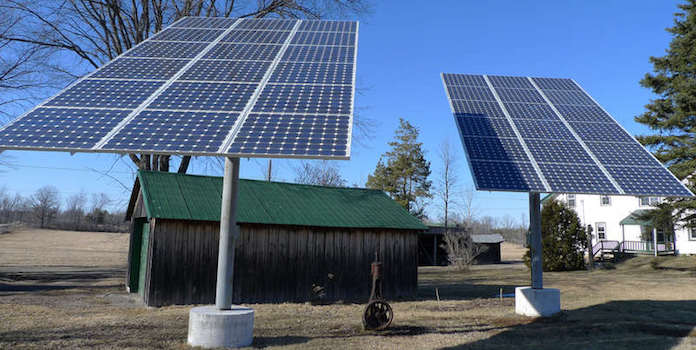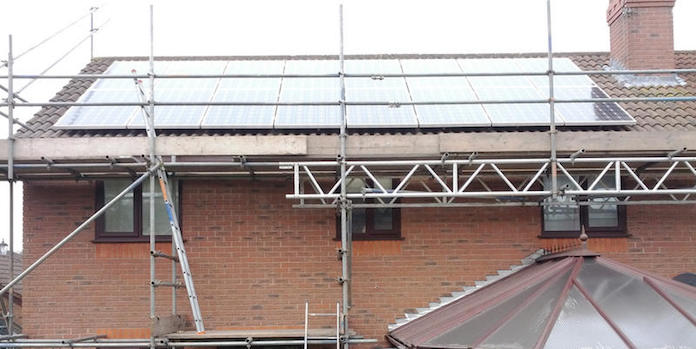Why Backyard Solar Panels Are More Expensive

If your roof is not pitch perfect for solar panels, what do you need to consider regarding backyard solar panels?
Considering installing solar panels and weighing up rooftop versus backyard solar panels?
In this article, we’re going to guide you by the hand through what you need to know, and all the areas where your installer might sneak in a few extra cents.
First, we’ll explain why backyard solar panels are more expensive than rooftop panels, and then we’ll look at additional costs to watch out for when making the solar switch.
Why Backyard Solar Panels Are More Expensive
Rooftop panels or no rooftop panels? That is the question. The answer: it depends on your situation. Sometimes you don’t have a choice, like if your roof is facing the wrong direction or is too small. But if you do, know that backyard solar panels are more expensive than their high-flying counterparts.
Here’s why.
Frame and Foundations
There are two types of ground-mounted systems: standard and single pole. The first is a simple frame that mounts solar panels, whereas the latter is a panel attached to a vertical pole. Both of these systems lift the panels off the ground and hold them at an angle to the sun. That means you need either a frame or a pole, plus a concrete foundation. These involve time, labor and material costs that you don’t have to worry about with roof-top panels.
Underground Wiring
To prevent Peter Rabbit munching through your $20,000 solar system, the wiring needs to be buried underground. Digging trenches costs money, which raises the cost of backyard solar panels.
They Take up Space
Rooftop panels are convenient because they’re out of the way. With backyard panels, not so. Now, what you can do with the space depends on whether you go for standard or single pole, but there’s no escaping it. These things hog space. If you’ve got tons kicking around, right on. If not, covering your postage stamp-sized yard with solar panels won’t produce much power anyway.
Also, if you’ve got a family home, having half your garden covered with solar panels might put off potential buyers with kids. Barbecue extraordinaire’s too.
Space isn’t what makes backyard panels cost more than rooftop panels, but the opportunity cost and how they will affect selling your house are points worth considering.
More Likely to Get Damaged
I don’t know about you, but my childhood consisted of many a football almost breaking my mom’s windows. And windows are relatively unobtrusive. A 5×5 solar array is another matter entirely. Granted, solar panels can take a beating. But in a fight between ten-year-olds playing baseball and your shiny investment? I’m taking the ten-year-olds.
Again, it’s not a direct cost like trenching, frames and foundations, but if you’ve got a lively backyard, it’s a cost to ponder. Plus, the greater likelihood of damage, the greater the insurance cost.
In short:
Frames, foundations, trenching, space and damage all mean that backyard solar panels are more expensive than their roof-top counterparts. Of course, it’s not just the cost to consider. Backyard panels have many advantages too. Being able to align them with the sun with or without tracking systems, ease of cleaning, plus air underneath keeping them cool makes backyard panels more efficient than rooftop systems.
Additional Costs of Solar Installation

Whichever system you go with, here are some additional costs that you’ll want to discuss with your installer up front.
Distance
The further the installer has to drive to get to you, the more it costs. Those four hours of driving to the wilds of Alaska each way add up to more than just 80’s radio hits. Alternatively, if your installer rolls out of bed onto your suburban roof, your wallet might just give you a cuddle.
Complexity of the Job
The simpler the job, the less time it takes, so you pay for fewer man-hours. Flat roof? Simple. Getting solar panels installed on your dodecahedral bohemian masterpiece? It’s going to cost you more.
Type of Roof
For rooftop panels, roof material matters. If it’s made of sturdy material that won’t break when installers walk on it, bingo. If it’s liable to break under a workman’s boot, like Spanish tile, then the installers will have to replace the broken tiles with extras. The additional costs come out of your pocket. Furthermore, if the roof angle is sub-optimal, you’ll have to pay for a frame to tilt the panels.
Roof Damage
If your roof needs repairing, it’s not a good idea for installers to be bolting through hefty bolts to keep your solar panels in place. Any damage done to a bad roof has to be paid for by you. Certified installers will do their best, but keeping your roof in good condition is your responsibility.
If you know your roof needs repairing, get it done before you buy solar panels because taking them off again will cost you extra.
Monitoring and Tracking Systems
Some companies offer to sell you systems that monitor your solar energy production. These will cost you extra, as will tracking systems that allow your panels to follow the sun. Added complexity always costs more.
Building Permits
If the bureaucrats kick up a fuss and wrap the project in red tape, time is wasted. That time is money, and that money adds expense to the project.
Inverter Upgrades
Inverters convert the unusable DC electricity from your solar panels to usable AC electricity to power your home. If you’re planning to add more solar panels to your system in the future, you may need a bigger inverter to handle it. Bigger inverters cost more money.
Conclusion:
As always, if you have any doubts, drop us a comment below and contact your solar installer. Knowledge is power, so run through these factors before you buy to make sure there are no nasty surprises down the line.
Here’s a run-down of all the factors discussed. Backyard solar panels are more expensive because:
- You need frames and foundations built.
- Wiring needs to be buried underground.
- They take up space. (Think opportunity cost and potential buyers of your home)
- More likely to be damaged.
Additional costs to consider and discuss with your installer:
- Where you live.
- The complexity of the job.
- Type of roof.
- Roof damage.
- Monitoring and tracking systems.
- Building permits.
- Inverter upgrades.
